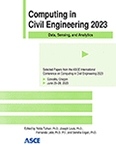Inhibitory Control Behavior of Novice and Experienced Drivers during Work Zone Intrusion: Functional Connectivity Analysis Using fNIRS
Publication: Computing in Civil Engineering 2023
ABSTRACT
While driving is a mentally demanding task, driving on roads that include maintaining and repairing construction activities can heighten the complexity of this task. Within work zones, drivers may fail to properly process road construction signs, which can highly threaten road construction workers’ safety. However, drivers’ control over the vehicle and the inhibitory control ability are important to prevent accidents. While previous studies investigated inhibitory control among drivers, they lack natural settings with the presence of an auditory stimulus. To bridge this gap, this study investigated expert and novice drivers’ neural activity and inhibitory control while intruding into a work zone equipped with auditory intrusion alert technology. Results showed that experts had higher neural activity within the prefrontal cortex while showing better response inhibition. Such knowledge can increase road safety professionals’ knowledge regarding the interventions that are needed to increase work zones’ safety.
Get full access to this article
View all available purchase options and get full access to this chapter.
REFERENCES
BLS. (2020). Accessed February 11, (2023). https://workzonesafety.org/work-zone-data/worker-fatalities-and-injuries-at-road-construction-sites/.
Clarke, D. D., and W. Truman. (2002). In-depth accident causation study of young drivers Prepared for Road Safety Division, Department for Transport, Local Government and the Regions.
Eshel, N., E. E. Nelson, R. J. Blair, D. S. Pine, and M. Ernst. (2007). “Neural substrates of choice selection in adults and adolescents: development of the ventrolateral prefrontal and anterior cingulate cortices.” Neuropsychologia, 45(6), 1270–1279. Neuropsychologia. https://doi.org/10.1016/J.NEUROPSYCHOLOGIA.2006.10.004.
Foy, H. J., P. Runham, and P. Chapman. (2016). “Prefrontal cortex activation and young driver behaviour: A fNIRS study.” PLoS One, 11(5), e0156512. Public Library of Science. https://doi.org/10.1371/JOURNAL.PONE.0156512.
Giedd, J. N. (2004). “Structural magnetic resonance imaging of the adolescent brain.” Ann. N. Y. Acad. Sci., 1021, 77–85. Ann N Y Acad Sci. https://doi.org/10.1196/ANNALS.1308.009.
Ishii-Takahashi, A., et al. (2014). “Prefrontal activation during inhibitory control measured by near-infrared spectroscopy for differentiating between autism spectrum disorders and attention deficit hyperactivity disorder in adults.” NeuroImage Clin., 4, 53–63. Elsevier. https://doi.org/10.1016/J.NICL.2013.10.002.
Ivers, R., T. Senserrick, S. Boufous, M. Stevenson, H. Y. Chen, M. Woodward, and R. Norton. (2009). “Novice drivers’ risky driving behavior, risk perception, and crash risk: Findings from the DRIVE study.” Am. J. Public Health, 99(9), 1638–1644. American Public Health Association. https://doi.org/10.2105/AJPH.2008.150367.
Koenigs, M., and J. Grafman. (2009). “The functional neuroanatomy of depression: Distinct roles for ventromedial and dorsolateral prefrontal cortex.” Behav. Brain Res., 201(2), 239–243. Elsevier. https://doi.org/10.1016/J.BBR.2009.03.004.
Luijten, M., M. W. J. Machielsen, D. J. Veltman, R. Hester, L. de Haan, and I. H. A. Franken. (2014). “Systematic review of ERP and fMRI studies investigating inhibitory control and error processing in people with substance dependence and behavioural addictions.” J. Psychiatry Neurosci., 39(3), 149–169. J Psychiatry Neurosci. https://doi.org/10.1503/JPN.130052.
Mwamba, I. C., M. Morshedi, S. Padhye, A. Davatgari, S. Yoon, S. Labi, M. Hastak, and P. U. J. T. R. Program, and O. S. U. S. of C. & E. Engineering. (2021). “Synthesis Study of Best Practices for Mapping and Coordinating Detours for Maintenance of Traffic (MOT) and Risk Assessment for Duration of Traffic Control Activities.” West Lafayette, IN: Purdue University. https://doi.org/10.5703/1288284317344.
Pokharkar, H. S. (2022). Enhancing active work zone safety with intrusion alert technologies: empirical evidence on effectiveness and implications. Purdue University Graduate School.
Pooladvand, S., D. Ay, and S. Hasanzadeh. (2022). “The Neural Basis of Risk Attitude in Decision-Making Under Risk: fNIRS investigation of the Simulated Electrical Construction Task.” ISARC 2022- Proc. 34th Int. Symp. Autom. Robot. Constr.
Pooladvand, S., and S. Hasanzadeh. (2022). “Neurophysiological evaluation of workers’ decision dynamics under time pressure and increased mental demand.” Autom. Constr., 141 (December 2021): 104437. Elsevier B.V. https://doi.org/10.1016/j.autcon.2022.104437.
Information & Authors
Information
Published In
History
Published online: Jan 25, 2024
ASCE Technical Topics:
- Audits
- Business management
- Construction engineering
- Construction industry
- Construction management
- Construction sites
- Driver behavior
- Employment
- Financial management
- Highway and road management
- Highway transportation
- Highways and roads
- Infrastructure
- Infrastructure construction
- Labor
- Occupational safety
- Personnel management
- Practice and Profession
- Public administration
- Public health and safety
- Safety
- Traffic engineering
- Traffic management
- Traffic safety
- Transportation engineering
- Work zones
Authors
Metrics & Citations
Metrics
Citations
Download citation
If you have the appropriate software installed, you can download article citation data to the citation manager of your choice. Simply select your manager software from the list below and click Download.
